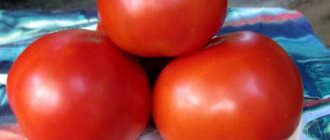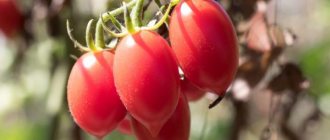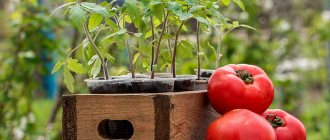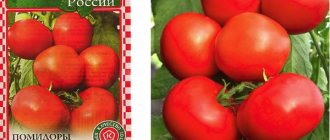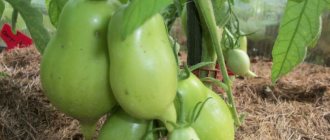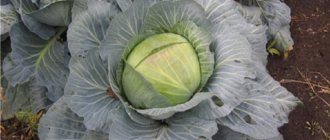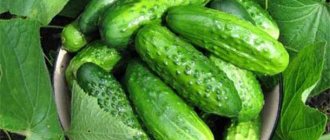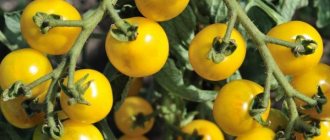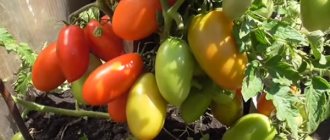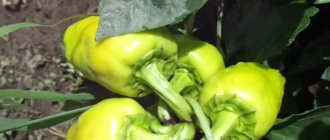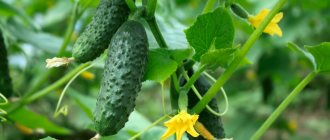Paratunka F1 is a productive, hardy and easy to grow parthenocarpic hybrid. It is relevant for gardeners and large farmers and serves as an excellent alternative to early varieties.
| Landing location | Ripening time | Mode of application | Fruit length | Group | Fruit smoothness | Pollination method |
| Universal | Early ripening (35-45 days) | Universal | Medium - from 10 to 15 cm | Hybrid | Highly lumpy | Parthenocarpic |
Description and characteristics of the variety
Paratunka F1 is distinguished by excellent productivity and uniform fruiting; it does not require pollinators to set. The hybrid is not inferior to the analogue Parus (from “Gavrish”) and the Kurazh cucumber in terms of endurance, fertility and durability.
Cucumbers are marketable and attractive in appearance. Ripening begins 40 days from planting.
Paratunka F1 from Zelentsy has the following description:
- length 8-12 cm;
- weight 90-100 g;
- light ribbing;
- single small tubercles;
- rare pubescence;
- the pulp is juicy, crispy;
- elongated cylindrical shape;
- triangular cut.
History of variety selection
The hybrid appeared in 2006. It is a first generation hybrid. Breeders from the agricultural company Semko took part in the breeding.
Biological features
Among the characteristics of the hybrid:
- tall bushes within 2-3 m (indeterminate growth);
- predominance of female inflorescences;
- parthenocarpic properties;
- moderate branching;
- the presence of 4 fruits in 1 node.
Application area
A high-yielding and commercial hybrid is used for preparing various dishes. It is used for fresh cuts and salads, for canning and pickling, assorted dishes and snacks.
Origin and development
The hybrid was bred by domestic breeder Alekseev. The base variety for creation was Parus, which is distinguished by productivity and germination. The cucumber is included in the State Register.
The variety is recommended for protected and open beds in large and small areas.
Landing region
The hybrid is actively cultivated in various climatic conditions. Suitable for cultivation:
- middle lane;
- North Caucasus;
- Chernozem region;
- Northwest;
- Kuban.
Paratunka F1: description of the cucumber variety, how to grow, reviews from gardeners
Cucumbers and tomatoes are the most popular vegetables in the human diet; these vegetable crops are also popular in garden beds. Currently, summer residents not only grow time-tested varieties of cucumbers, but also plant new ones in order to select ones that are suitable for yield, with early or medium ripening of fruits and with other improved characteristics.
Those who want to get early-ripening, productive cucumbers on their plot should pay attention to Paratunka hybrid cucumbers, which are so productive that they are grown not only in private farmsteads, but also on an industrial scale.
The content of the article:
1. History of creation 2. Description of the variety and main 3. Productivity of the Paratunka cucumber variety 4. Diseases and pests 5. Advantages of the variety 6. Planting cucumbers 7. Further care 8. How to feed properly 9. Reviews of the Paratunka F1 cucumber
Advantages and disadvantages
Pros:
- good transportability;
- long shelf life;
- high product and taste qualities;
- when overgrown, yellowing and expansion of the form do not occur;
- tolerance of unfavorable conditions;
- complex resistance to diseases;
- productivity.
Minuses:
- Use only fresh;
- the importance of fertilizing;
- weakness of roots;
- arrangement of trellises for garter.
Cucumber Paratunka F1: reviews from those who planted
Olga, 55 years old, Belgorod: I have been growing this variety for several seasons in a row. The first time I bought the seeds of this hybrid by accident, I planted one bed, as a result, the bushes of this variety began to bear fruit approximately 1.5 months after the sprouts appeared, and ovaries appeared on the vines throughout the summer. As a result, I salted and pickled a large number of jars from one garden bed, which we ate throughout the winter. I can say that both pickled and pickled cucumbers of the Paratunka variety have excellent taste - all my family is delighted.
Maria, 67 years old, Kursk region: I grow various vegetables in my garden, but my family doesn’t need anything other than cucumbers - they eat them fresh, lightly salted, pickled. Therefore, I spent a long time choosing varieties of this vegetable crop with high yields and good taste of the fruits. I settled on the hybrid Paratunka - it doesn’t require much care, it grows well and bears fruit in my greenhouse. During the season I collect so many cucumbers from the beds that there is enough for everything. I see only one drawback with this variety - I have to buy seeds in the store every year. But their cost is compensated by the high yield of the variety.
Valya, 48 years old, Saratov region: I have been growing this variety for several years, I bought them specifically for the greenhouse, where I plant Paratunka cucumbers at the end of April. And by mid-July, my family and I are eating fresh cucumbers from our garden. The only thing I would like to say is that the cost of seed material is quite high.
Kristina, 37 years old, Ulyanovsk region: A colleague at work treated me to delicious crispy cucumbers that she had preserved herself. I asked what variety it was - it turned out to be Paratunka. A colleague told me about the high yield of the variety and decided that next season I would definitely plant the same variety in my greenhouse.
The Paratunka cucumber variety can be grown in most Russian regions (even with a short summer period), since it grows and bears fruit only in greenhouses or greenhouses, where it is protected from adverse weather conditions.
And its high yield, pleasant taste of Paratunka cucumber fruits and ease of care are the main positive properties that will appeal even to novice vegetable growers.
Landing
The hybrid is actively cultivated in open ground, in protected beds - in a greenhouse, greenhouse, tunnel. Seeds for seedlings are sown 1 month before the planned transplant. Sowing is carried out to a depth of 2 cm. Volumetric containers are used for seedlings - pots of 0.3-0.4 liters, boxes with sides of 10 cm. The nutrient mixture for planting is made up of the following components:
- compost;
- humus;
- peat;
- turf;
- sand.
Before sowing, moisten the soil, make furrows and place the seeds at a distance of 10 cm. In order for the seedlings to grow strong, the following conditions are maintained:
- create a temperature regime of 22-24 degrees and humidity of 80-85%;
- irrigate with settled water;
- illuminated with phytolamps for 14-15 hours;
- feed with nitroammophoska when 2 leaves appear.
The bushes are ready for transplanting when there are 3-4 leaves. Before planting, seedlings are hardened off for 7-10 days.
Planting density is 3-4 plants per 1 m2.
The crop is grown without seedlings in the southern and temperate regions. Seeds are sown in beds when the ground warms up to 12-14 degrees. Recesses are made at a distance of 30 cm.
Features of agricultural technology
Sowing
The Paratunka f1 variety can be grown with dry seeds directly into the ground or by seedlings.
- To obtain full-fledged seedlings, sowing begins in the last ten days of April or early May. The plant experiences stress during transplantation, so it is best to use peat cups or special detachable containers. In this case, the root system will not be damaged. When real leaves (3-4) appear on the plant, you can plant it in a permanent place.
- When sowing seeds directly into the ground, special attention should be paid to the depth: no more than 2 cm. Before planting, the seeds are soaked to ensure germination. Sowing is done in a checkerboard pattern, with 3 to 4 seeds per square meter.
Rules of care
Attention! Paratunka cucumbers should be watered in the evening using warm water.
After watering, the soil under the cucumbers should be loosened to a shallow depth. The plant requires fertilizing. You can use special compounds or slurry.
Don't lose your harvest
Since Paratunka f1 varietal cucumbers are early ripening, it is necessary to pinch the crown. New ovaries will begin to form in the sinuses. Small greens should be collected every other day early in the morning.
Important! The harvesting of cucumbers of this variety must be active, this significantly increases the yield.
Growing rules and care
Not only professionals, but also novice farmers can easily grow cucumbers. The hybrid is planted near a trellis structure or horizontally in a garden bed. Among the agrotechnical practices, the following procedures are important:
- Watering. Carry out with a frequency of 1 time in 2-3 days. Water in the evening with warm water. The amount of liquid per bush is 3-5 liters.
- Shaping and garter. The branches are fixed as they grow, the central trunk is tucked or pinched at the level of the top of the support.
- Loosening and removal of weeds. The procedure is carried out at least once a week.
- Mulching the surface with a layer of straw or sawdust. Thickness 8-9 cm.
- Conducting fertilizing. Alternately add organic matter and minerals to the garden bed once every 2 weeks.
When using the trellis version, the growing points are pinched, the shoots and inflorescences are removed up to the 5th leaf. This is necessary for better ventilation and increased tying. The side stems are shortened after the 2-3rd leaf. When reaching the trellis, the trunks are pruned.
When introduced horizontally, the lower stems are added dropwise, this strengthens the roots. Pinching is carried out at the same time. The surface of the bed is mulched with peat or hay.
To renew the bush, old leaves and branches are pruned. The growth areas of the shoots are pinched to stimulate the growth of new stems.
Fertilizers are used:
- 1:12 diluted solutions of mullein and dung;
- complex mixtures - Agronomist, Agricola, Complement, Good Strength;
- mineral compositions - nitroammophosphate, saltpeter, superphosphate, potassium sulfate.
Diseases and pests
The cucumber hybrid Paratunka has high immunity, so it is practically not affected by the following diseases:
- brown spotting;
- powdery mildew;
- bacteriosis.
If cucumbers have to be grown in not very favorable conditions, then it is recommended to treat the vines for preventive purposes with appropriate preparations in order to protect the cucumber bushes from possible diseases.
But it should be remembered that Paratunka cucumbers can be damaged by the following diseases and pests:
- root and white rot;
- anthracnose;
- penosporosis;
- aphids;
- spider mite.
If signs of disease or the presence of pests are found on the plant, then such bushes should be removed from the garden bed and immediately burned, and all neighboring cucumber vines should be treated with the necessary fungicides and insecticides.
Cucumber varieties!
Granddaughter F1 Mother-in-law F1 Zozulya F1
Also, in order to prevent the appearance of diseases or “harmful” bugs, it is necessary to carry out the following preventive measures:
- the distance between neighboring cucumber plants should be optimal to prevent thickening;
- control soil moisture so that it is not too high;
- regularly inspect the foliage of cucumbers and the stems of bushes in order to promptly detect the presence of “harmful” bugs or symptoms of disease;
- regularly remove all weeds from the area;
- loosen the soil after each watering;
- Before starting sowing or transplanting cucumber seedlings, it is necessary to treat the soil with a disinfecting solution.
General description of the hybrid
“Paratunka” is a cucumber variety widely known among ordinary summer residents and experienced farmers, and is actively grown throughout Russia. In 2005, the hybrid was included in the State Register of the Russian Federation as approved for cultivation in any geographical zone of the country.
The plant of this variety belongs to the indeterminate type, that is, growth is not limited to the flower shoot and can reach three meters in length. Branching is not very well developed. The hybrid is early ripening and bears fruit already on the fortieth day from germination. Fruiting is long, until frost. “Paratunka” pollinates independently, without attracting insects and other plants. This quality allows the variety to be grown indoors.
The variety is characterized by bunched ovaries. At the genetic level, Paratunka plants have the ability to form from five to ten ovaries from one node. This indicates the high yield of the hybrid. From one square meter you can get about 20 kg of fruit.
Cucumbers are a cylindrical variety with a slightly bumpy surface and white spines. The fruits are predominantly the same size, growing about 10 cm in length and up to 3.5 cm in diameter. Weight ranges from 80-100 grams. The vegetables taste juicy, sweetish and have a strong cucumber aroma. Genetically, the fruits lack a bitter taste.
Vegetables with these characteristics are great for eating in fresh summer salads, as well as for pickling and pickling.
Housewives love “Paratunka” for the same size of fruits and crispy preserved pulp. Interesting! Everyone knows that cucumber is a vegetable that consists of 97% water. The calorie content of this product is 15 kcal per 100 grams. Despite this, eating cucumbers quickly makes you feel full. The combination of these properties is actively used in dietetics; with the help of such miracle vegetables it is very easy to lose excess weight. And the tatronic acids contained in the fruits perfectly process carbohydrates and prevent the gain of extra pounds.
Watering and fertilizing
Despite the fact that this variety of cucumbers is not capricious, it will not be possible to achieve good yields if the watering regime is improperly organized. Since the Paratunka horse system is located in close proximity to the soil surface, cucumbers need good watering. To do this, it is advisable to use warm water. The best time to water is early morning or late evening.
Fertilizing affects productivity. Even if the soil is fertile, the lack of fertilizing will negatively affect the quantity and quality of fruits. Feeding is especially important during the period of fruit development and formation.
Fertilizer
Experienced gardeners recommend using a solution of mullein or chicken manure dissolved in water as a top dressing. You can also achieve high yields if you feed the plants with ready-made mineral fertilizers. During the fruiting season, cucumbers need to be fed at least 4 times.
Reviews
Reviews about the Paratunka F1 hybrid are mostly positive .
Cucumber lovers are especially captivated by the long fruiting and lack of bitterness in the fruit. Valery, Rostov : “For some time now I have increased the area of my summer cottage and, accordingly, the crops.
I decided to plant more cucumbers. When the question arose of which variety to choose, I preferred Paratunka among the hybrids. Our family liked these cucumbers due to their long fruiting time and high yield. Fresh fruit salad was prepared almost until late autumn.” Galina, Novgorod : “All my life I grew ordinary cucumbers, I was suspicious of hybrids, considering them almost mutants. What kind of cucumber is it if nothing worthwhile can be grown from its seeds? My son and daughter-in-law have been growing the Paratunka hybrid for several seasons. And I became attached to it: the cucumbers are smooth, elastic, never bitter, and ideal for pickling. So now my opinion about hybrids is positive.”
Inna, Belgorod : “My husband and I grow cucumbers for sale. The Paratunka hybrid tolerates transportation well and is readily accepted by traders. We practically didn’t encounter any diseases, they also taste good: sweetish, with a crunch.”
Characteristics of Paratunka cucumbers
The Paratunka F1 hybrid was created in 2006 based on the popular Parus variety, supplied by the Russian. It has good yield and is not particularly demanding on growing conditions.
Distinctive features
The hybrid is suitable for cultivation in summer cottages and for industrial production in farm cucumber plantations.
Paratunka produces a large harvest when grown both on trellises and on the ground. Moreover, the lashes quickly begin to take root on the soil. Vegetable growers have long noticed this distinctive feature and use it to strengthen the root system of the plant, which in cucumbers, especially hybrid ones, is traditionally weak and susceptible to disease.
Composition and properties
Like most of its fellows, the Paratunka cucumber consists of 95% water. The fruit has almost no voids and has few seeds.
Nutritional value of the product (per 100 g):
- calorie content - 14 kcal;
- proteins – 0.8 g;
- fat – 0.1 g;
- carbohydrates – 2.5 g;
- organic acids – 0.1 g;
- fiber – 1 g;
- glycemic index – 25.
In addition, the culture is rich in vitamins C and K, groups A and B. The fruit contains minerals such as iron, copper, manganese and many others. Cucumbers also contain iodine, which prevents thyroid diseases.
Regular consumption of fresh cucumbers can help remove small stones and sand from the kidneys and improve intestinal motility. But the vegetable is contraindicated in the diet if the stones in the kidneys and bile ducts are large.
Eating fruits accelerates the removal of fluid from the body, which lowers blood pressure, so hypotensive patients should use cucumbers with caution.
The plant is medium tall, medium bushy. With good care, bushes can stretch up to 3 m in length.
The leaves are dense, light green or dark in color, medium in size. The hybrid does not require pollination; it is parthenocarpic, that is, only female flowers grow on the bushes.
Paratunka is an early ripening hybrid. The first fruits are harvested approximately a month after germination. Fruiting continues until the first frost, almost the entire season.
The fruits grow about 9 cm long, up to 3 cm in diameter. The color of the skin of cucumbers is dark green, the average weight of a cucumber is 100 g. The fruits have a few tubercles and pronounced spines, have a characteristic cucumber aroma, and the flesh is crisp. The taste of these cucumbers has a sweetish tint.
Productivity with proper care is 15–17 kg per 1 sq. m.
This variety, like other cucumbers, has poorly developed roots. Their main part is located in the upper layer of soil, only a small amount goes to a depth of 20 cm. The roots in the upper layer always lack moisture, especially at the time of fruiting.
The stem of this vegetable is branched and long. If formed correctly and the trellis is of sufficient height, it can reach 2 m in length. In the internodes, first-order branches are formed, which provoke the growth of subsequent shoots. The plant grows well on a trellis.
If the branch reaches the ground, it immediately takes root. This feature helps gardeners strengthen the root system, so they specially dig them in. Productivity depends on the correct development of roots. There can be up to 4 flowers in the axils, mostly of the female type. There are also 4 ovaries.
Description of fruits
According to the description, Paratunka cucumbers have a cylindrical shape with dark green stripes of medium length. Each cucumber weighs about 100 g. The taste is pleasant, without the slightest bitterness.
The Paratunka cucumber belongs to the indeterminate type, which is distinguished by the fact that the flower shoot can grow up to 3 meters in length. Branching is not very developed. The hybrid ripens early and bears the first fruits already 40 days after planting. Fruits almost until the first frost. The Paratunka cucumber is pollinated independently. This quality allows you to grow this variety indoors.
The Paratunka cucumber variety does not require special care skills. The first collections can be carried out on days 35–45.
In central Russia, Paratunka cucumber seeds are placed in peat tablets for growing seedlings. The recommended time is early May, when warm weather has already established itself. By the end of spring or early summer, young cucumbers with 3-4 leaves are moved into the ground. If you plan to plant in open ground immediately, it is better to do this in the last days of spring.
According to reviews, the yield of Paratunka cucumber seeds per 1 sq. m is, with proper care, approximately 15 kg.
Application area
The Paratunka hybrid cucumber ripens very early and is characterized by high yield. Suitable for eating fresh, salted or pickled. It has a pleasant taste, so it is often used to make salads.
Paratunka cucumber seeds are resistant to many diseases, even if they grow in unfavorable conditions. If you spray the plant with special preparations, you can be sure that the entire harvest will remain intact. During sowing, there is no need to additionally disinfect the seeds, since the manufacturer has already treated them with fungicides.
Paratunka cucumbers may be threatened by the following diseases and pests:
- root and white rot;
- anthracnose;
- peronosporosis;
- aphid;
- spider mite
If signs of disease or pests are found on the Paratunka cucumber bush, it must be removed immediately and the remaining ones processed. Timely prevention will help preserve the harvest. It includes the following activities:
- cucumbers should be planted as rarely as possible;
- control soil moisture - it should be moderate;
- inspect the bushes daily to promptly identify diseases and pests;
- regularly control weeds;
- loosen the soil;
- disinfect the area before sowing seeds and planting.
If you follow all the recommendations, you can get a good harvest that will not be afraid of diseases and pests.
Paratunka cucumber has a number of advantages over other varieties:
- small green leaves perfectly transmit light and moisture;
- the variety is self-pollinating;
- high speed of fruit ripening - after 35-45 days you can begin harvesting the first harvest;
- long fruiting period;
- pleasant taste of fruits, without bitterness;
- high resistance to many diseases;
- versatility - suitable for pickling, preparing snacks or eating fresh.
The Paratunka cucumber also has its disadvantages:
- weak root system - if it does not develop correctly, the plant will lack moisture;
- the need for active and abundant watering;
- requires additional devices for the correct formation of the bush.
But thanks to the high yield and pleasant taste, the disadvantages are not so significant.
Plant care
“Paratunka” is one of the most unpretentious representatives of the cucumber family. Therefore, caring for plants consists of simple agrotechnical techniques:
Bush formation
The variety is characterized by unlimited growth of the main stem, so the formation of a bush is a mandatory procedure. If you neglect this agricultural technique, the plants will spread uncontrollably and fill the entire space. This will negatively affect fruiting and resistance of cucumbers to diseases.
When growing “Paratunka” using a trellis method, the plant is formed into one stem and several small lateral ones. As soon as the main lash reaches the top of the support, the crown of the head is carefully pinched. Simultaneously with pinching, all side shoots are removed to the level of growth of the third leaf on the main stem. All the lashes that form below must also be pinched after the formation of the third leaf. The bulk of the crop is removed from the central vine.
When growing horizontally, experts recommend leaving only one main stem for growth, and removing the rest immediately as they grow.
With any planting method, it is necessary to remove yellowed or diseased leaves and shoots weekly, this will prevent the spread of infection.
Watering
Water the cucumbers from a watering can with exclusively warm and settled water. The watering can must have a nozzle that prevents erosion of the plant roots, which are located mainly in the upper layer of soil. “Paratunka”, like all cucumbers, requires daily watering, but if this is not possible, watering is carried out less frequently, but more abundantly, and the soil must be mulched. The best time for watering is considered to be in the evening; the sun is no longer so active and if moisture gets on the leaves, it will be possible to avoid burns.
Feeding
You can feed cucumber beds with both specialized compounds for cucumbers and folk remedies. Two weeks after germination or transplanting into the ground, the plants are fed with nitrogen fertilizers. Mullein diluted in water is excellent for this. During flowering, the soil is fertilized with wood ash tincture. This infusion contains all the micro- and macroelements necessary for cucumber. In order to prolong fruiting as long as possible, the third feeding should contain potassium and nitrogen. This will give the plant strength for further growth and the formation of new ovaries.
Protection from diseases and pests
“Paratunka” is a variety that has fairly strong immunity to the main diseases of cucumbers. But in conditions of high humidity, plants can develop root or white rot. Among the pests that can attack vegetable beds are white aphids and spider mites. Therefore, cucumber vines must be regularly inspected to identify diseases and parasites. If one or the other is detected, the affected parts of the plants are removed and the bush is treated with special means approved for use during fruiting. If the plant is severely affected, it is mercilessly removed, otherwise the disease will instantly spread to all cucumbers.
But as you know, it is better to follow preventive measures to avoid problems. The best prevention for cucumbers is to follow the planting pattern, timely formation of bushes and disinfection of the soil before planting.
Advice! To scare away pests from the cucumber bed, experienced gardeners plant flowers with pungent odors or herbs next to the crop. For example, calendula, marigolds, onions and garlic.
Harvest dates and schedule
Those wishing to breed the early-ripening cucumber hybrid Paratunka F1 should take into account the abundant fruiting of the variety. The first harvest can be tasted 45 days after planting the seeds. But you won’t have to wait long for subsequent fruits, so don’t forget to check the vines every day when collecting greens.
The more often you pick fruits from the stems, the larger the harvest will be. Fruiting of this hybrid lasts until frost. Do not allow the skin of the fruit to turn yellow, because such specimens lose the tenderness of the pulp, aroma and taste. Cucumbers up to 7 cm long are optimal for harvesting.
Paratunka cucumbers are advantageous for growing due to their abundant and early fruiting. If you follow basic agrotechnical rules, the crop will demonstrate high resistance to typical diseases and pests, and will also reward you with fresh, juicy fruits throughout the summer.
